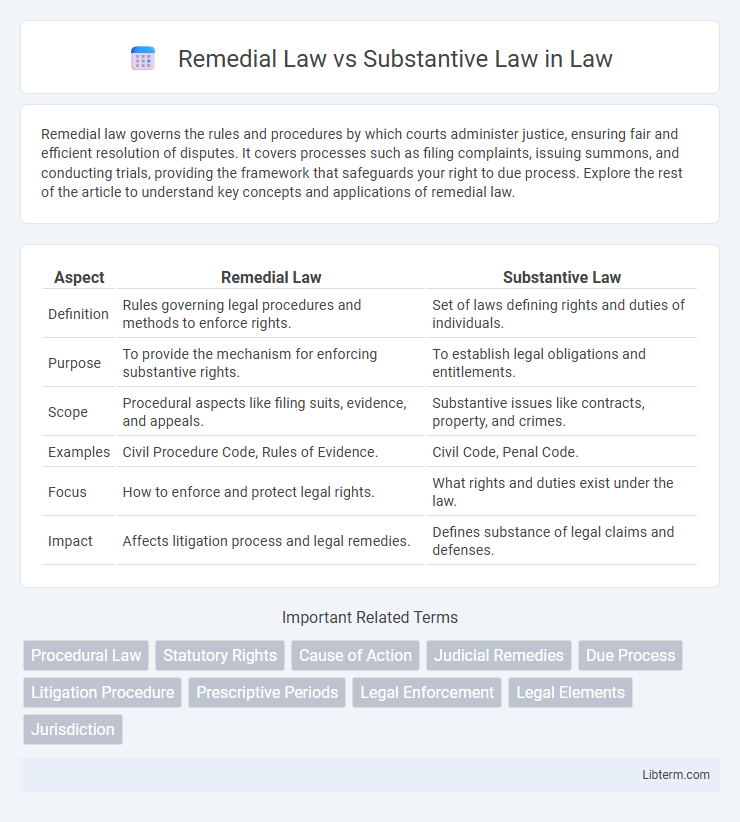Remedial law governs the rules and procedures by which courts administer justice, ensuring fair and efficient resolution of disputes. It covers processes such as filing complaints, issuing summons, and conducting trials, providing the framework that safeguards your right to due process. Explore the rest of the article to understand key concepts and applications of remedial law.
Table of Comparison
| Aspect | Remedial Law | Substantive Law |
|---|---|---|
| Definition | Rules governing legal procedures and methods to enforce rights. | Set of laws defining rights and duties of individuals. |
| Purpose | To provide the mechanism for enforcing substantive rights. | To establish legal obligations and entitlements. |
| Scope | Procedural aspects like filing suits, evidence, and appeals. | Substantive issues like contracts, property, and crimes. |
| Examples | Civil Procedure Code, Rules of Evidence. | Civil Code, Penal Code. |
| Focus | How to enforce and protect legal rights. | What rights and duties exist under the law. |
| Impact | Affects litigation process and legal remedies. | Defines substance of legal claims and defenses. |
Introduction to Remedial and Substantive Law
Remedial law, also known as procedural law, governs the process and methods for enforcing rights and obtaining remedies through the legal system. Substantive law defines the actual rights and duties of individuals and the legal relationships between them, establishing the grounds for legal claims. Understanding the distinction clarifies how rights are protected (substantive law) and how legal actions are conducted (remedial law) in judicial proceedings.
Definition of Substantive Law
Substantive law defines the rights and duties of individuals and collective entities, establishing the legal relationship between parties and the framework for the enforcement of these rights. It includes laws related to contracts, torts, property, and criminal offenses that govern behavior and specify remedies or penalties for violations. This contrasts with remedial law, which outlines the procedures and methods for enforcing substantive rights in the judicial system.
Definition of Remedial Law
Remedial Law refers to the set of legal principles and rules that determine the process and method by which the rights of individuals are enforced or protected in courts. It governs the procedures for filing lawsuits, presenting evidence, and obtaining judgments, ensuring access to justice and the fair administration of law. Unlike Substantive Law, which defines the rights and duties of individuals, Remedial Law focuses on the mechanisms for enforcing those rights.
Key Differences between Remedial Law and Substantive Law
Remedial law governs the procedures and methods for enforcing legal rights and obtaining remedies, while substantive law defines the actual rights and duties of individuals. The primary difference lies in their purpose: remedial law provides the means to protect rights, whereas substantive law establishes the content of those rights and obligations. Understanding this distinction is crucial for legal practitioners when applying legal principles in court proceedings.
Functions of Substantive Law in Legal Systems
Substantive law defines the rights and duties of individuals and collective bodies, establishing the legal relationships and obligations within society. It provides the framework for determining legal entitlements and liabilities in civil, criminal, and administrative contexts. By setting the standards for lawful conduct, substantive law underpins the enforcement mechanisms facilitated by remedial law.
Functions of Remedial Law in Legal Proceedings
Remedial law functions to establish the methods and procedures for enforcing rights and obtaining remedies in legal proceedings, ensuring access to justice by guiding how cases are processed from initiation to resolution. It includes rules on jurisdiction, pleadings, evidence, and execution of judgments, facilitating the practical application of substantive rights. These procedural safeguards maintain fairness and due process, allowing courts to effectively administer substantive law.
Examples of Substantive Law
Substantive law defines legal rights and obligations, such as criminal statutes like the Theft Prevention Act and civil codes governing contracts and property rights. Examples of substantive law include the Revised Penal Code, which outlines offenses and penalties, and the Civil Code, which regulates marriage, succession, and obligations. These laws establish the framework for determining liability and the nature of legal relationships between parties.
Examples of Remedial Law
Remedial law includes legal provisions that outline the methods and procedures for enforcing rights and obtaining remedies in court cases, such as rules of civil procedure, criminal procedure codes, and laws governing evidence presentation. Examples of remedial law encompass the Rules of Court that dictate how a lawsuit is filed, the Philippine Rules of Evidence that guide admissibility of proof, and procedural statutes like the Anti-Hazing Act which specify how violations are to be prosecuted. These laws ensure that substantive rights, such as property ownership or contractual rights, are effectively protected through accessible and orderly judicial processes.
Importance of Distinguishing Remedial and Substantive Law
Distinguishing remedial law from substantive law is vital for properly interpreting and applying legal rules, as substantive law defines rights and obligations while remedial law provides the procedures to enforce those rights. Misclassification can lead to procedural errors, jurisdictional issues, or dismissal of cases, affecting access to justice and the proper administration of law. Clear differentiation ensures that courts apply the correct legal standards and processes, safeguarding fairness and legal certainty.
Impact on Legal Rights and Procedures
Remedial law shapes the methods and procedures for enforcing and protecting legal rights, directly influencing how claims are presented and adjudicated in court. Substantive law defines the actual rights and duties, determining the legal relationships and entitlements of parties involved. The distinction impacts legal outcomes by ensuring procedural fairness through remedial rules while establishing the foundational rights governed by substantive law.
Remedial Law Infographic

 libterm.com
libterm.com